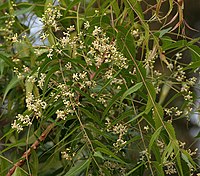
Photo from wikipedia
The extensive use of nondegradable chemical pesticides for pest management has developed serious environmental hazards. This has necessitated the urgent need to switch over to an alternative mode of biopesticide… Click to show full abstract
The extensive use of nondegradable chemical pesticides for pest management has developed serious environmental hazards. This has necessitated the urgent need to switch over to an alternative mode of biopesticide development for mass agriculture and field crop protection. Azadirachta indica A. Juss (commonly known as neem) houses a plethora of bioactive secondary metabolites with azadirachtin being the most active constituent explored in the sector of ecofriendly and biodegradable biopesticides characterized by low toxicity toward nontarget organisms. It has been reported that the highest content of azadirachtin and related limonoids is present in the seeds, available once in a year. Moreover, the inconsistent content and purity of the metabolites in whole plant makes it imperative to tap the potential of in vitro plant tissue culture applications, which would allow for several controlled manipulations for better yield and productivities. This review gives a summarized literature of the applied research and achievements in plant cell/hairy cultures of A. indica A. Juss mainly in context with the biopesticide azadirachtin and applications thereof.
Journal Title: Engineering in Life Sciences
Year Published: 2017
Link to full text (if available)
Share on Social Media: Sign Up to like & get
recommendations!